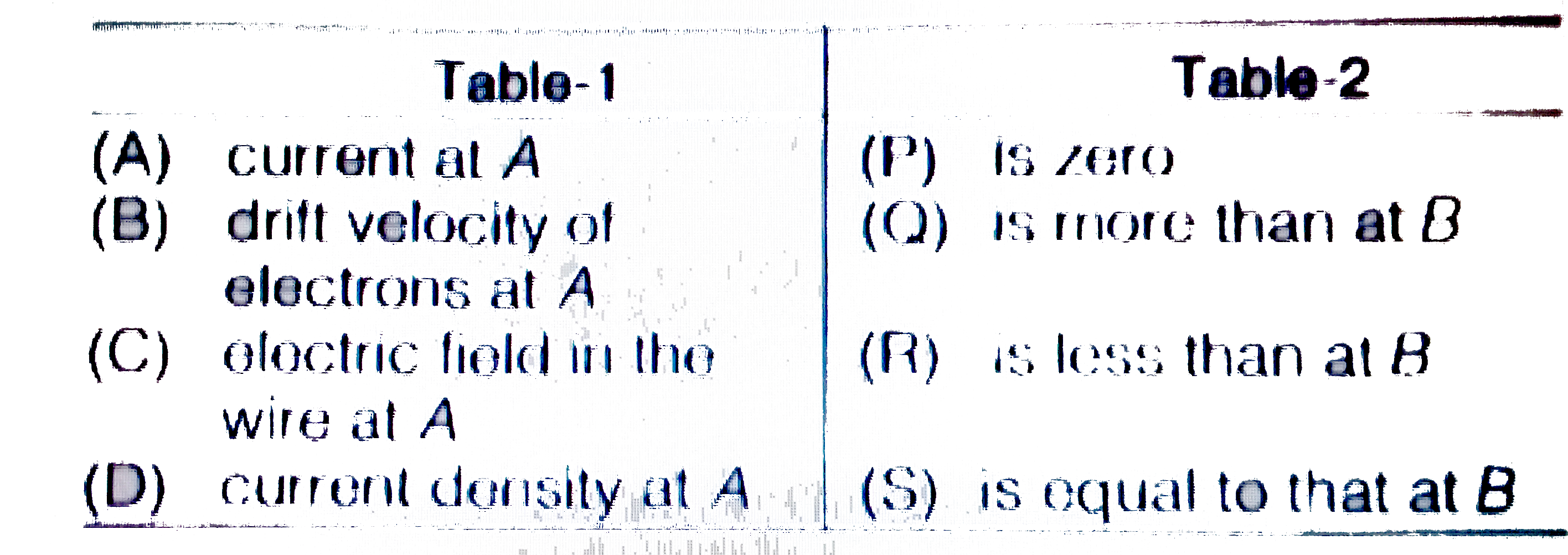A current passes through a wire of nonuniform cross-section. Which of the following quantites are independent of the cross section?Solution in Gujrati
(a)The charge crossing in a given time interval
(b)Drift speed
(c )Current density
(d)Free-electron density
The correct Answer is:A, D
Step by step video & image solution for A current passes through a wire of nonuniform cross-section. Which of the following quantites are independent of the cross section? by Physics experts to help you in doubts & scoring excellent marks in Class 12 exams.
Updated on:21/07/2023Topper's Solved these Questions
- ELECTRIC CURRENT IN CONDUCTORSBOOK - HC VERMACHAPTER - ELECTRIC CURRENT IN CONDUCTORSEXERCISE - Exercises
84 Videos
- ELECTRIC CURRENT IN CONDUCTORSBOOK - HC VERMACHAPTER - ELECTRIC CURRENT IN CONDUCTORSEXERCISE - Objective 1
16 Videos
- DISPERSION AND SPECTRABOOK - HC VERMACHAPTER - DISPERSION AND SPECTRAEXERCISE - Exercises
11 Videos
- ELECTRIC CURRENT THROUGH GASESBOOK - HC VERMACHAPTER - ELECTRIC CURRENT THROUGH GASESEXERCISE - Exercises
23 Videos
Similar Questions
The amount of charge passed in time t through a cross-section of a wire is
Q(t)=At2+Bt+C.
(a)Write the dimensional formulae for A,B and C.
(b) If the numerical values of A,B,and C are 5,3 and 1 respectively in SI units,find the value of the current at t=5 s.
View SolutionA metallic resistor is connected across a battery.If the number of collisions if the free electrons with the lattice is somehow decreased in the resistor (for example,by cooling it ),the current will
View SolutionA flint glass prism and a crown glass prism are to be combined in such a way that the deviation of the mean ray is zero. The refractive index of flint and crown glasses for the mean ray are 1.620 and 1.518 respectively. If the refracting angle of the flint prism is 6.0∘, what would be the refracting angle of the crown prism ?
View SolutionA discharge tube contains helium at a low pressure. A large potential difference is applied across the tube. Consider a helium atom that has just been ionized due to the detachment of an atomic electron. Find the ratio of the distance travelled by the free electron to that by the positive ion in a short time dt after the ionization.
View SolutionA current passes through a wire of nonuniform cross-section. Which of the following quantites are independent of the cross section?
View SolutionA steady current is passing through a linear conductor of non-uniform cross-section. The net quantity of charge crossing any cross-section per second is.
View SolutionCurrent is flowing through a wire of non-uniform cross section. Cross section of wire at A is les than the cross section of wire at B. Then match the following

View SolutionAssertion : If a current flows through a wire of non-uniform cross-section, potential difference per unit length of wire is same throughout the length of wire. Reason : Current through the wire is same at all cross-sections.
View SolutionThe current through a wire depends on time as i=(2+3t)A . Calculate the charge crossed through a cross section of the wire in 10sec.
View SolutionA steady current is passing through a conductor of non-uniform cross-section . The net quantity of charge crossing any cross-section per second is
View SolutionA current passes through a wire of nonuniform cross-section. Which of the following quantites are independent of the cross section?
View SolutionA current passes through a wire of nonuniform cross section. Which of the following quantities are independent of the cross- section?
View SolutionA steady current is passing through a linear conductor of nonuniform cross-section. The drift velocity of electrons
View SolutionGiven a current carrying wire of nonuniform cross section. Which of the following quantity or quantities are constant throughout the length of the wire?
View SolutionCurrent is flowing through a wire of non-uniform cross section. Cross section of wire at A is les than the cross section of wire at B. Then match the following
View SolutionAssertion : If a current flows through a wire of non-uniform cross-section, potential difference per unit length of wire is same throughout the length of wire.
Reason : Current through the wire is same at all cross-sections.
View Solution
